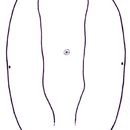en
names in breadcrumbs


The species is spread in all continents investigated so far. It was originally described from littoral mesopsammon (3 mm), 15–20 m from the shore, of the Bulgarian part of the Black Sea at Spatnite pjasatzi near Varna, July, salinity ~18‰. Only a few more, but undocumented records exist from Russia (White and Barents Sea), Europe (the Channel, Mediterranean), USA (Gulf of Mexico) and a tidal river on Peninsular Malaysia. Studying zooplankton in 104 arctic rockpools of different salt content along the shores of the islands in the White and Barents Sea, it has been reported the species from fresh-, brackish- and marine waters.
The species is widespread and apparently perennial. The water temperatures of 15–38 °C it was found, suggest that it prefers warm waters. It occurs from the intertidal zone to at least 10 km off shore, up to a depth of 50 m, in the mesopsammon and along marine coasts. Testudinella obscura appears to be an interstitial element and may live only in that habitat.
The lorica is more or less elliptical, weakly truncate anteriorly, smooth or occasionally very weakly striated. Ratio lorica length/lorica width 1.43–1.71 (average 1.54). The dorsal anterior margin shows a broad, flat median part connected by shallow folds to smaller rounded lateral lobes. The ventral margin is slightly convex to weakly undulate, with shallow median indentation. The dorsal anterior margin is not or slightly projecting beyond the ventral margin. The posterior margin is smoothly rounded or very weakly rounded-angular. In cross-section the lorica is slightly arched dorsally with shallow elevation near the lateral margins; ventrally almost flat with median part protruding. The foot opening is sub-terminal, on the ventral side; it takes the shape of an inverted U-shaped slit, the lateral margins of which sometimes appear undulate. The foot is composed of a long wrinkled proximal part, a short penultimate and a longer distal pseudosegment ending in a ciliated cup. The ratio lorica length/position of antennae relative to the antero-dorsal margin varies between 2.40–2.88 (average 2.60) for the dorsal antenna and 1.97–2.23 (average 2.07) for the lateral antennae. Two red eyespots.
Trophi malleoramate. The rami are elongate triangular with rounded latero-ventral margins, and very short blunt alulae. Basal and subbasal chambers forming single large chamber, opening latero-ventrally by a large common fenestra. Asymmetrical and interlocking median apophyses are apparent in caudal view. The inner margins of the distal rami sections bear 10–16/11–16 (left/right) arched and strongly webbed rami scleropili. The basal apophyses are moderately developed ridges, composed of a series of fused scleropili. The fulcrum is short, plank-shaped, and more or less trapezoid in lateral view. It is composed of a double layer of long and appressed sclerite bodies, the greatest part of which is involved in the formation of the junction with the rami, and another series situated anteriorly which border a distinct proximal opening. The unci plates are composed of 10–12/11–12 (left/right) straight and strongly webbed teeth, lying parallel. There are three major teeth with distinctly offset club-shaped head in each uncus; the head of the midst tooth is distinctly smaller than the others. The space between the minor teeth is fairly large, and their weakly offset head is cylindrical to elongate-lanceolate. The crescent shaped manubria are composed of a superimposed dorsal, median, ventral and well developed subventral chamber.
Male unknown